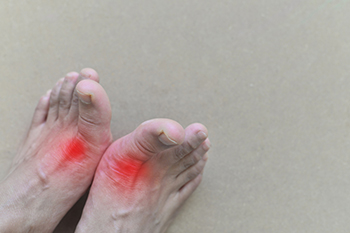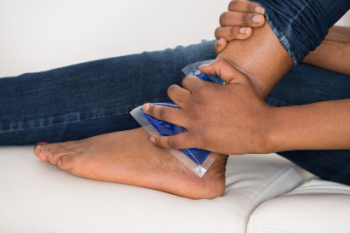Connect With Us
Blog
Items filtered by date: February 2025
Living With Gout

Gout is a type of arthritis caused by a buildup of uric acid crystals in the joints, often affecting the big toe. It is more common in men and people with high levels of uric acid in their blood, which can result from poor diet, obesity, or certain medical conditions like kidney disease. Gout attacks are sudden and intense, often described as sharp, throbbing pain that can feel like the affected joint is on fire. The area becomes swollen, red, and tender to the touch, making it difficult to move the foot or walk. These flare-ups can last for days or weeks if not treated. To manage gout, lifestyle changes such as reducing alcohol and eating purine-rich foods like red meat are key. Anti-inflammatory medications and uric acid-lowering drugs can help relieve pain and prevent future attacks. A podiatrist can provide customized care, offer medication management, and suggest foot-friendly changes to alleviate pressure on the affected joint. If you are experiencing gout symptoms, it is suggested that you schedule an appointment with a podiatrist for effective treatment.
Gout is a painful condition that can be treated. If you are seeking treatment, contact Elie C. Daniel, DPM from Illinois. Our doctor will treat your foot and ankle needs.
What Is Gout?
Gout is a form of arthritis that is characterized by sudden, severe attacks of pain, redness, and tenderness in the joints. The condition usually affects the joint at the base of the big toe. A gout attack can occur at any random time, such as the middle of the night while you are asleep.
Symptoms
- Intense Joint Pain - Usually around the large joint of your big toe, and it most severe within the first four to twelve hours
- Lingering Discomfort - Joint discomfort may last from a few days to a few weeks
- Inflammation and Redness -Affected joints may become swollen, tender, warm and red
- Limited Range of Motion - May experience a decrease in joint mobility
Risk Factors
- Genetics - If family members have gout, you’re more likely to have it
- Medications - Diuretic medications can raise uric acid levels
- Gender/Age - Gout is more common in men until the age of 60. It is believed that estrogen protects women until that point
- Diet - Eating red meat and shellfish increases your risk
- Alcohol - Having more than two alcoholic drinks per day increases your risk
- Obesity - Obese people are at a higher risk for gout
Prior to visiting your podiatrist to receive treatment for gout, there are a few things you should do beforehand. If you have gout you should write down your symptoms--including when they started and how often you experience them, important medical information you may have, and any questions you may have. Writing down these three things will help your podiatrist in assessing your specific situation so that he or she may provide the best route of treatment for you.
If you have any questions, please feel free to contact our offices located in Princeton, Peru, and Mendota, IL . We offer the newest diagnostic and treatment technologies for all your foot care needs.
Frequency of Achilles Tendon Injuries in Athletes

Achilles tendon injuries are among the most common seen in athletes, particularly those involved in running, jumping, or sports requiring explosive movements. The Achilles tendon, which connects the calf muscles to the heel bone, is essential for mobility, providing the necessary strength and flexibility for activities like sprinting, jumping, and walking. Athletes who participate in high-intensity sports such as basketball, soccer, and track are at a higher risk of experiencing Achilles tendon injuries, often due to repetitive strain or sudden, forceful movements. These injuries can range from tendinitis, which causes inflammation and pain, to complete tendon tears, which may require surgery for recovery. Overuse, inadequate warm-up routines, poor footwear, and muscle imbalances are common contributing factors. If you are athletic and have sustained an Achille tendon injury, it is suggested that you consult a podiatrist who can offer effective treatment solutions, enabling you to return to your desired sport as quickly as possible.
Achilles tendon injuries need immediate attention to avoid future complications. If you have any concerns, contact Elie C. Daniel, DPM of Illinois. Our doctor can provide the care you need to keep you pain-free and on your feet.
What Is the Achilles Tendon?
The Achilles tendon is a tendon that connects the lower leg muscles and calf to the heel of the foot. It is the strongest tendon in the human body and is essential for making movement possible. Because this tendon is such an integral part of the body, any injuries to it can create immense difficulties and should immediately be presented to a doctor.
What Are the Symptoms of an Achilles Tendon Injury?
There are various types of injuries that can affect the Achilles tendon. The two most common injuries are Achilles tendinitis and ruptures of the tendon.
Achilles Tendinitis Symptoms
- Inflammation
- Dull to severe pain
- Increased blood flow to the tendon
- Thickening of the tendon
Rupture Symptoms
- Extreme pain and swelling in the foot
- Total immobility
Treatment and Prevention
Achilles tendon injuries are diagnosed by a thorough physical evaluation, which can include an MRI. Treatment involves rest, physical therapy, and in some cases, surgery. However, various preventative measures can be taken to avoid these injuries, such as:
- Thorough stretching of the tendon before and after exercise
- Strengthening exercises like calf raises, squats, leg curls, leg extensions, leg raises, lunges, and leg presses
If you have any questions please feel free to contact our offices located in Princeton, Peru, and Mendota, IL . We offer the newest diagnostic tools and technology to treat your foot and ankle needs.
Key Differences of Walking and Running Shoes

Walking and running shoes are designed with specific features to support each activity’s unique movements. Walking shoes are typically lighter and more flexible, with a lower heel-to-toe drop that promotes a smooth, natural stride. They are built to offer comfort and stability, as walking involves less impact on the feet. Running shoes are designed to handle the repetitive high-impact forces of running. These shoes usually have more cushioning, especially in the heel and forefoot areas, to absorb shock and protect joints. Running shoes also provide better arch support to accommodate the constant push-off and landing that occurs while running. Both types of shoes prioritize comfort, but walking shoes emphasize support and flexibility, while running shoes focus on cushioning and shock absorption. If you have sustained a foot injury while running, it is suggested that you contact a podiatrist who can treat various foot conditions and guide you on what type of running or walking shoes to wear.
For more information about walking shoes versus running shoes, consult with Elie C. Daniel, DPM from Illinois. Our doctor can measure your feet to determine what your needs are and help you find an appropriate pair of footwear.
Foot Health: The Differences between Walking & Running Shoes
There are great ways to stay in shape: running and walking are two great exercises to a healthy lifestyle. It is important to know that running shoes and walking shoes are not interchangeable. There is a key difference on how the feet hit the ground when someone is running or walking. This is why one should be aware that a shoe is designed differently for each activity.
You may be asking yourself what the real differences are between walking and running shoes and the answers may shock you.
Differences
Walking doesn’t involve as much stress or impact on the feet as running does. However, this doesn’t mean that you should be any less prepared. When you’re walking, you land on your heels and have your foot roll forward. This rolling motion requires additional support to the feet.
Flexibility – Walking shoes are designed to have soft, flexible soles. This allows the walker to push off easily with each step.
If you have any questions, please feel free to contact our offices located in Princeton, Peru, and Mendota, IL . We offer the newest diagnostic and treatment technologies for all your foot care needs.
Chronic Ankle Instability and Pain

Chronic ankle instability occurs when the ankle repeatedly gives out, often due to weakened ligaments from prior injuries like sprains. Over time, the ligaments fail to provide sufficient support, leading to instability and persistent pain. This condition is common in athletes and individuals who engage in activities involving quick turns or uneven surfaces. The pain typically feels like a dull ache or sharp twinge on the outer side of the ankle, often worsening with activity. Swelling, tenderness, and a sense of wobbliness may accompany the discomfort. Repeated instability can cause further injuries, cartilage damage, or arthritis. If you have chronic ankle stability, it is suggested that you see a podiatrist who can recommend treatments such as targeted exercises to strengthen the ankle, bracing for support, or, in severe cases, surgery.
Ankle pain can have many different causes and the pain may potentially be serious. If you have ankle pain, consult with Elie C. Daniel, DPM from Illinois. Our doctor will assess your condition and provide you with quality foot and ankle treatment.
Ankle pain is any condition that causes pain in the ankle. Due to the fact that the ankle consists of tendons, muscles, bones, and ligaments, ankle pain can come from a number of different conditions.
Causes
The most common causes of ankle pain include:
- Types of arthritis (rheumatoid, osteoarthritis, and gout)
- Ankle sprains
- Broken ankles
- Achilles tendinitis
- Achilles tendon rupture
- Stress fractures
- Tarsal tunnel syndrome
- Plantar fasciitis
Symptoms
Symptoms of ankle injury vary based upon the condition. Pain may include general pain and discomfort, swelling, aching, redness, bruising, burning or stabbing sensations, and/or loss of sensation.
Diagnosis
Due to the wide variety of potential causes of ankle pain, podiatrists will utilize a number of different methods to properly diagnose ankle pain. This can include asking for personal and family medical histories and of any recent injuries. Further diagnosis may include sensation tests, a physical examination, and potentially x-rays or other imaging tests.
Treatment
Just as the range of causes varies widely, so do treatments. Some more common treatments are rest, ice packs, keeping pressure off the foot, orthotics and braces, medication for inflammation and pain, and surgery.
If you have any questions, please feel free to contact our offices located in Princeton, Peru, and Mendota, IL . We offer the newest diagnostic and treatment technologies for all your foot care needs.
